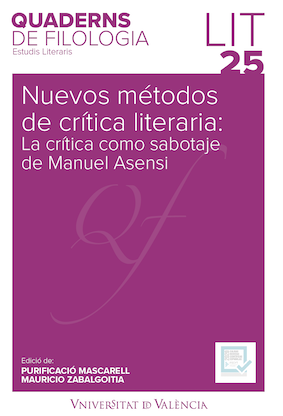Crítica (com a sabotatge) a La república del vino de Mo Yan
DOI:
https://doi.org/10.7203/qdfed.25.18982Paraules clau:
Asensi, crítica com a sabotatge, Mo Yan, La república del vino, sociocrítica. Resum
Resum
El present treball intenta utilitzar la teoria de crítica com a sabotatge per a realitzar una anàlisi a La república del vino. Mitjançant una “lectura atenta (close reading)” i una revisió detinguda del context, la intertextualidad, l'estil irònic i paròdic i la complexitat de l'espai literari d'aquesta novel·la, tractem d'analitzar la “reducció al·legòrica” d'aquest “afepto”, amb l'objectiu de veure com es troben els tres models de món i com Mo compleix la funció literària i social –de “reflectir, explicar i modificar la realitat social” (Rodríguez Puértolas, 2008: 41)– d'un escriptor.
 Descàrregues
Descàrregues
Descàrregues
Publicades
Com citar
-
Resum485
-
PDF (Español)271
Número
Secció
Llicència
 Este obra está bajo una licencia de Creative Commons Reconocimiento-NoComercial-SinObraDerivada 4.0 Internacional.
Este obra está bajo una licencia de Creative Commons Reconocimiento-NoComercial-SinObraDerivada 4.0 Internacional.
Tots els documents inclosos a OJS són d'accés lliure i propietat dels seus autors i/o institucions editores, i per tant, qualsevol acte de reproducció, comercialització, comunicació pública o transformació total o parcial necessita el consentiment exprés i escrit d'aquests.
________
Authors who publish with this journal agree to the following terms:
- Authors retain copyright and grant the journal right of first publication with the work simultaneously licensed under a Creative Commons Attribution License that allows others to share the work with an acknowledgement of the work's authorship and initial publication in this journal.
- Authors are able to enter into separate, additional contractual arrangements for the non-exclusive distribution of the journal's published version of the work (e.g., post it to an institutional repository or publish it in a book), with an acknowledgement of its initial publication in this journal.
- Authors are permitted and encouraged to post their work online (e.g., in institutional repositories or on their website) prior to and during the submission process, as it can lead to productive exchanges, as well as earlier and greater citation of published work (See The Effect of Open Access).



